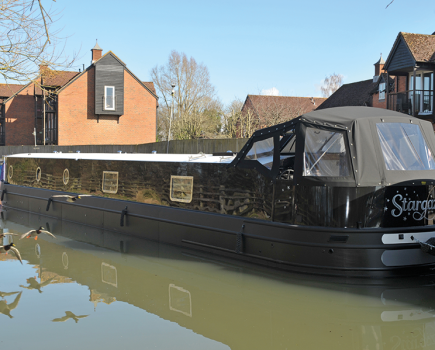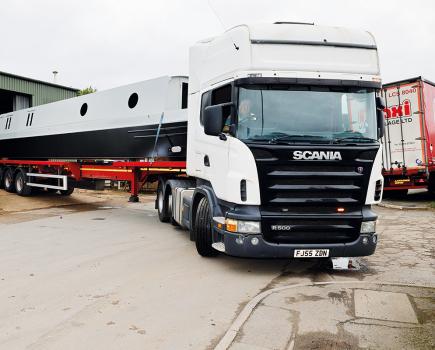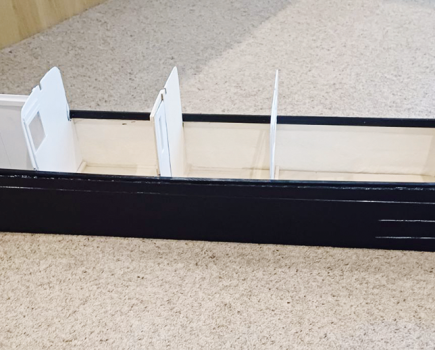Sheerline Josher powered by bombproof classic Gardner power plant combines traditional touches with modern technology

People who have a thing about engines seldom do half measures: when they like engines, they really like engines. Take the owners of this boat, Dave Onslow and Kay Fay. Dave bought the vintage Gardner engine which powers Silent Waters ten years ago — and it’s been sitting in his garage ever since, just waiting until he was in a position to put it in a boat.
When you’ve got such a lot invested in a piece of machinery, the boat it ends up should be pretty special — and fortunately this one is. It’s been built by Bourne Boat Builders, who won the Favourite Boat title at the Crick Boat Show last year. The difference in power plants between the two boats is about as extreme as you can get. Last year’s boat had a hybrid system, which meant it could travel silently using its electric motor; the Gardner in this one (in spite of the name Silent Waters) is so loud it can be heard about half a mile away.

EXTERIOR
Silent Waters is built on a beautiful 66ft shell by Tim Tyler. It’s one of his sheer line Joshers, which means that in addition to the curvy Josher style bow, the gunwales also have a sweeping curve which is reflected in the cabin top, with a distinct lift at the stern. Whichever way you look at it, this is a very attractive shell.
There are lots of traditional touches too, such as protruding gunwales and handrails, to mimic the wooden ones that old working boats would have had. There’s also a full set of rivets, big chunky dollies at the stern, one of which also has a substantial hook, and a couple of pigeon boxes on the roof. Dave and Kay also insisted that the portholes, mushroom vents and other trim should be brass rather than the more contemporary chrome, because they like the traditional look.
The colour scheme is classic too, with black borders and grey panels separated by a cream coach line. The roof is grey forward of the boatman’s beam, and raddle red aft of it. The sign writing is by Andy Russell, who has shown his artistic flair by also painting a fishing boat each side. This is in tribute to Dave’s grandfather, who had a fishing boat called Silent Waters in Devon while Dave was growing up.

There is a gas locker in the nose, while the water tank is under the well deck. The well deck itself has a heater, linked to the boat’s central heating system, and a tap for washing Sky the dog after muddy walks. There’s a locker across the front of the deck for storage and to give access to the bow thruster.
LAYOUT ANF FITOUT
This is a boat whose layout has really been determined by the choice of engine, because a Gardner needs its own room. So the saloon is at the bow, with the galley beyond. The cabin is at the centre of the boat, followed by the bathroom, which is an off-corridor design. The engine room comes next, with a back cabin at the stern.

The fitout uses a combination which has become a Bourne trademark: oak teamed with faux leather panels on the cabin sides. These are hard wearing and easy to keep clean, and give a soft look with some nice texture.
In the back cabin and engine room, the oak has been teamed with teak panels. It’s a very pleasing look, and a modern twist on a traditional couple of rooms. The floors throughout are made from Amtico.

SALOON
We’ll start at the bow, where a step brings you from the well deck into the saloon. On one side of the boat is a hearth with a tiled surround, and a Morso Squirrel stove with a double insulated flue. On the same side is a long run of under-gunwale cupboards. One includes an electrically operated tv, which rises from the unit at the press of a button on a small remote. It means the tv is easily accessible when needed, but out of sight when it’s not.
The main piece of furniture is a very large sofa, made bespoke by Elite furnishings. It converts easily into a bed, and is so long because Dave has a son who’s 6ft 4in tall — meaning he wouldn’t comfortably fit in the back cabin bed.
This is a very light space, because there’s a large Houdini hatch in the ceiling.

GALLEY
On one side of the galley is a beautiful Welsh dresser, with a range of cupboards and shelves, and a row of lovely little drawers. It’s apparently the first time Bourne has been asked to built something like this, and it’s a great success.

On the other side is a more conventional run of galley units, with oak doors and Minerva worktops. Above the sink is a set of side doors with glazed inner doors, so you can get light without draughts. Behind doors are a 24 volt Shoreline fridge, and a full size 24 volt freezer, also by Shoreline. There’s also a slim Miele dish washer, which should actually use less water than hand washing.
As this boat has lithium batteries, which provide masses of power, the oven is an electric one by Neff. It’s positioned at eye level in the centre of the boat and has a tilt and slide door, which is a real space saver. There’s a matching microwave above. Previous boats we’ve seen with lithium batteries have gone gas free and had an electric hob too, but Dave was concerned that the 5kw inverter installed would struggle if they wanted the hob and oven on at the same time. So there’s a Bosch four burner gas hob; as this is the only gas appliance on board, a bottle should last a very long time.

CABIN
The cabin has an in-line bed with a range of high level cupboards above. It also has a very attractive built-in head board, with fabric panels. The bed base contains the loo holding tank, and the calorifier.
The room has a substantial wardrobe at the foot of the bed, with folding doors. As well as a range of shelves and hanging space, there’s also a tv which comes out on an arm and flips down. It means the tv is out of the way, but the mechanism does take up a fair amount of space. The wardrobe extends along the corridor a couple of feet too, with more doors. The bottom half contains a washing machine.

BATHROOM
It’s a while since we’ve seen an off-corridor bathroom in a test boat, because many people are attracted by the extra space offered by a walk-through. However, there are advatages to an off-corridor —principally that you can always get from one end of the boat to the other, even when someone is using the facilities.
This particular room is generously proportioned, and has a cross bath with a shower above, rather than a shower cubicle. The decision was made because Dave felt a cubicle would make the room feel too small. Certainly the bath and its folding shower screen mean this room has plenty of airspace. Another clever feature which adds to the feeling of space is that rather than a traditional bathroom cabinet, there are doors set into the bulkhead. This cupboard is actually borrowing space from the back of the cabin wardrobe. The doors are mirrored, too.
There’s a corner unit with a cupboard, a composite worktop, and a large white basin. The loo is a macerater unit by Vetus. There’s a towel rail, and as this boat isn’t short of electrical power, there’s a fan heater too.
ENGINE ROOM
A sliding door which disappears into the bulkhead separates the engine room from the living quarters. The centrepiece (literally) of this room is the engine itself — of which more later. It’s a very attractive room, which packs a lot in. It’s here that the oak is joined by teak panels above the gunwales, and there are grey painted panels below, to match the grey of the engine.
In one corner there’s a tall, slim, triangular hanging cupboard for coats. In the other corner there’s a similarly shaped unit with a small stainless steel sink, for when you need to clean up after some engine tinkering. There’s another cupboard above.
A third corner has the electrical cupboard, where lots of things such as the inverter and battery monitor are hidden away. After all, they look much too modern for a room like this! To show off the engine, there are side doors both sides.
BACK CABIN
This is a very traditional back cabin in terms of layout, with a bench down one side and cupboards the other. These include a drop down table and a knife drawer, and a flap which drops down to form a cross bed in the traditional way. All the sections of mattress are kept inside. At the stern is a steerer’s step, with a traditional Epping stove alongside so the steerer is kept warm on a winter’s day and can have a kettle of water on the go.
The decision to fit out this room with oak and teak rather than painted scumbling is inspired. Both woods are classic boating materials, but their difference in colour gives a nice contrast. It’s a result which manages to be both classic and modern at the same time.
TECHNICAL
The Gardner 2LW engine dates from 1954, and Dave bought it more than ten years ago from Walsh Engineering in Manchester, who specialise in engines like this. He doesn’t know much about its past, except that it spent the first part of its life in South Africa, which probably means it was used down a mine. There’s a day diesel tank, with a manual pump. Much of the brasswork, including the silencer, was supplied by Redshaw’s in Braunston, who also made the controls.
The vintage engine contrasts with the electrical system. The battery bank consists of four 200Ah lithium-ion batteries from Victron. These have the advantage of being able to be discharged much more than normal batteries, and they charge up much quicker. They’re also predicted to have a much longer life; the claim is often twenty years or so (and some people believe they’ll actually go on much longer). They are expensive, though, at around £1500 each.
The system also includes a Victron battery management system, which monitors the batteries and makes sure they don’t over charge. If it detects anything wrong, it shuts down safely. There’s also a monitor with a colour display, to show what’s going in and out of the batteries at any one time, with remote access via a webpage.
The boat has a 24 volt system rather than the more usual 12 volts, as it’s more stable and suffers less voltage drop. A 240 volt supply comes from a Victron 5kw inverter.
The boat has a 95kgf Vetus bow thruster to help with manoeuvring. Heating comes from an Eberspacher diesel boiler.
ON THE WATER
This is a big heavy boat with a vintage engine and traditional controls, so steering it is quite different from many modern boats. There’s no getting away from the fact that the engine is loud: from the towpath you can hear the boat coming a long way off, and at the helm you have no chance of hearing what towpath walkers are saying to you. But it’s one of those noises that sounds right. An engine that looks like that should sound exactly like that.
The traditional controls include a handle which you push for forward gear and pull for reverse. In between is neutral, which I struggled to find during our test. Dave says it’s just a matter of getting used to it. Then there’s a speed wheel to control the revs. There’s clearly more to do than if you just had a Morse control, but you soon get the hang of it.
The Tim Tyler shell swims very nicely and creates very little wash. It has long swims so handling is excellent: the boat responds very quickly to the tiller, and because it’s rather deep draughted it feels very solid and secure. The bow thruster has enough grunt to help out against the stiff breeze we had during our test.
CONCLUSION
This is a lovely boat which in many ways seems contradictory, yet everything works together well. You don’t get a more traditional layout than an engine room and back cabin, yet the fitout gives it a modern twist. There’s an engine dating from the 1950s, but an electrical system that’s bang up to date. And Dave and his partner Kay haven’t been afraid to make their own choices, such as the off-corridor bathroom, rather than following current trends.
The price is £160,000 — excluding the engine, which Dave already owned. That’s a reflection of the size of the boat, and the expensive lithium battery system on board.
This boat is proof that a good builder can cope with all sorts of requirements, and can deliver exactly what their customers want. This boat is nothing like some of the other Bourne Boats we’ve seen (indeed it’s nothing like their second boat at this year’s Crick Show) but has the same high standard of fitout, and everything works properly together.
THE OWNER
Dave Onslow’s love of engines extends beyond the Gardner that he’s put in this boat. “I have a few motorbike engines in the living room at home” he says, while acknowledging that such a thing wouldn’t be everyone’s idea of home decor. It’s perhaps not surprising, as he has an engineering background, particularly in electrics.
Fay Kay is more interested in another sort of horse power — horse riding — although when we met the couple she had her arm in a sling after falling off. She had strict instructions not to move it too much, which meant lock work was out of the question for several weeks.
The couple live in Devon, but have managed to find a home marina for the boat which they can reach by train, so they can leave their car at home.
SPECIFICATIONS
Length: 66ft
Beam: 6ft 10in
Shell: Tyler Wilson
Style: Trad
Fit-out: Oak and teak
Layout: Standard
Berths: 2+2+2
Engine: Gardner 2LW
Inverter: Victron 5kw
Bow Thruster: Vetus 95kgf
Image(s) provided by:
Archant







